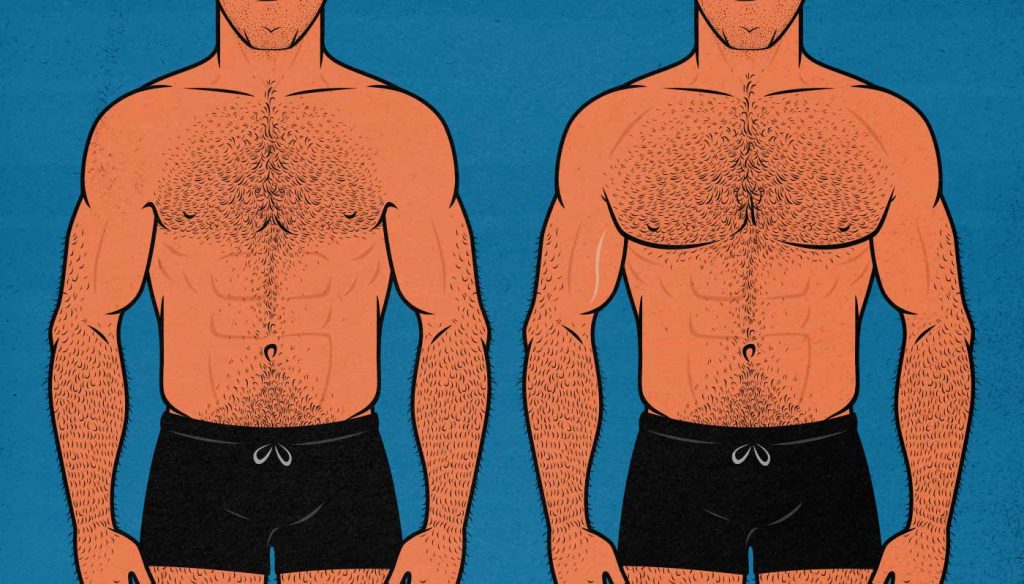
How to Build a Bigger Chest (Even If It’s Lagging Behind)
The chest is one of the biggest and most powerful muscles in our bodies, but it’s also notoriously difficult to grow, and many people find that it lags. In fact, if you’re a naturally skinny guy with narrow shoulders or a shallow ribcage, building a bigger chest may seem downright impossible. I’ve been there.
There are three principles that reliably improve chest growth:
- Choose exercises where your chest is the limiting factor, ensuring that it gets most of the growth stimulus. And if your upper chest is lagging, the same rule applies: choose lifts where your upper chest is the limiting factor.
- Challenge your chest under a deep stretch, improving how much muscle growth you stimulate with every set. As we’ll cover below, this can double your rate of muscle growth.
- Make sure that you’re achieving progressive overload, getting stronger over time, gradually lifting more weight or doing more repetitions. This includes eating enough protein and calories to recover and grow from your workouts.
If you can get stronger at lifts that are limited by the strength of your chest, then your chest will grow. And if those lifts challenge your chest under a deep stretch, it will grow much faster.
So, which lifts are best at challenging our chests through a deep range of motion? And how can we make sure that our chests are the limiting factor? Let’s dive in.
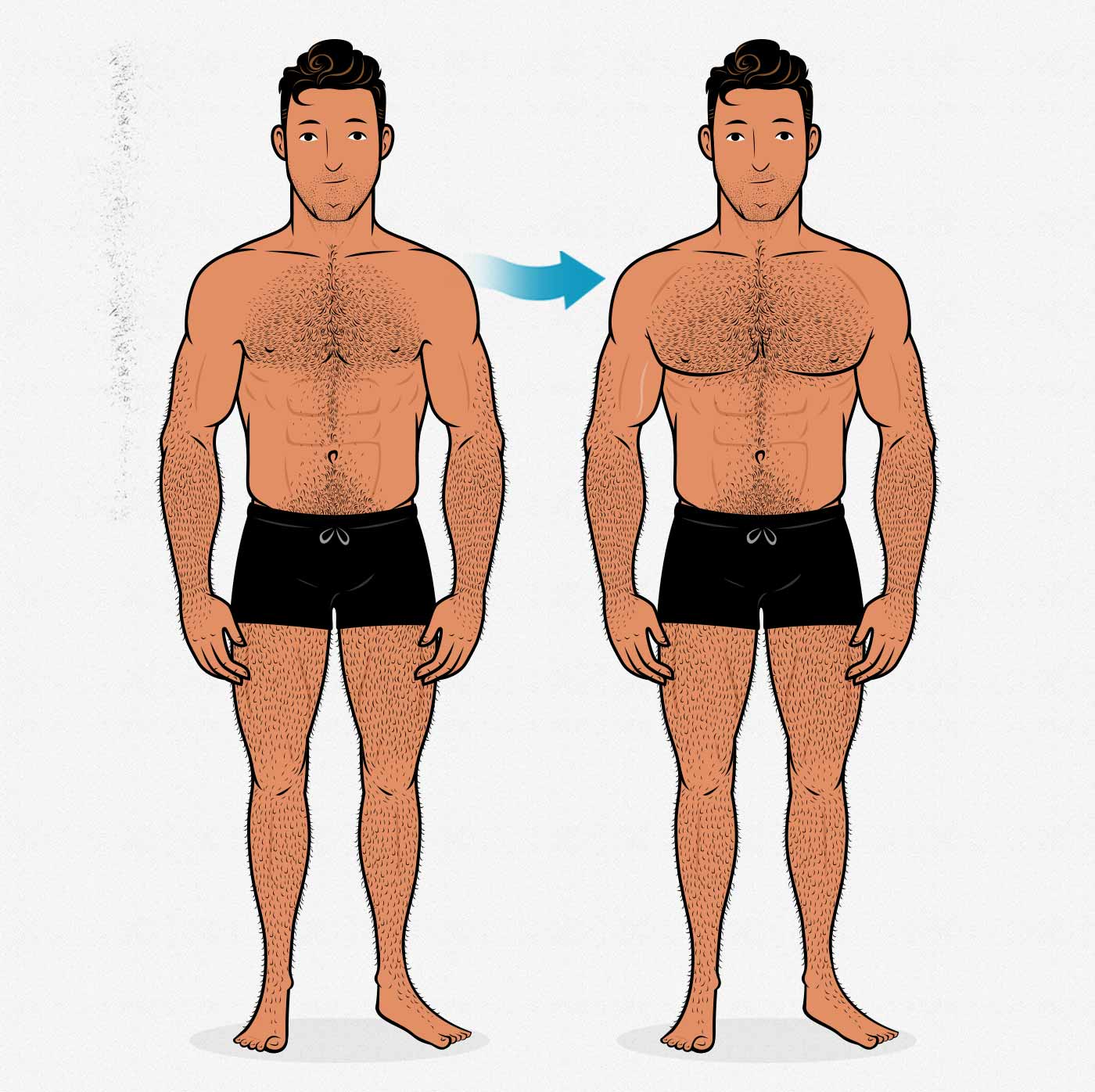
Introduction
During my first year of lifting weights, I barely made any progress on my chest. I was training it three times per week, but I wasn’t doing a good job of stimulating it, and I couldn’t figure out how to make it grow. To make matters worse, I struggled to bench press 65 pounds, and I couldn’t figure out how to get stronger.
That’s when I came into contact with my business partner, Marco. He taught me how to do the bench press with better technique, and he gave me a structured workout program to follow. Four months later, my chest had exploded in size:
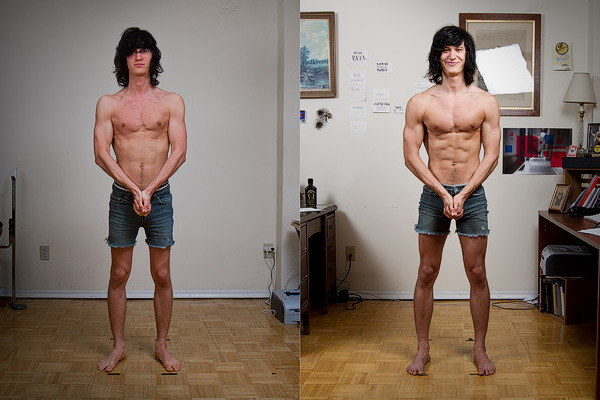
During those four months, my bench press quickly went from 65 pounds up to 135 pounds, and then it shot up to 185 pounds. And a couple of months after taking those photos, I accomplished my lifetime goal of benching 225 pounds for a set of 5 repetitions.
Then my bench press stalled for a long time. I continued gaining muscle, but I stopped putting as much emphasis on my chest. I was already happy with it. So I gradually worked my way up to a body weight of 195 pounds, trying to build bigger arms, a bigger back, and bigger legs.
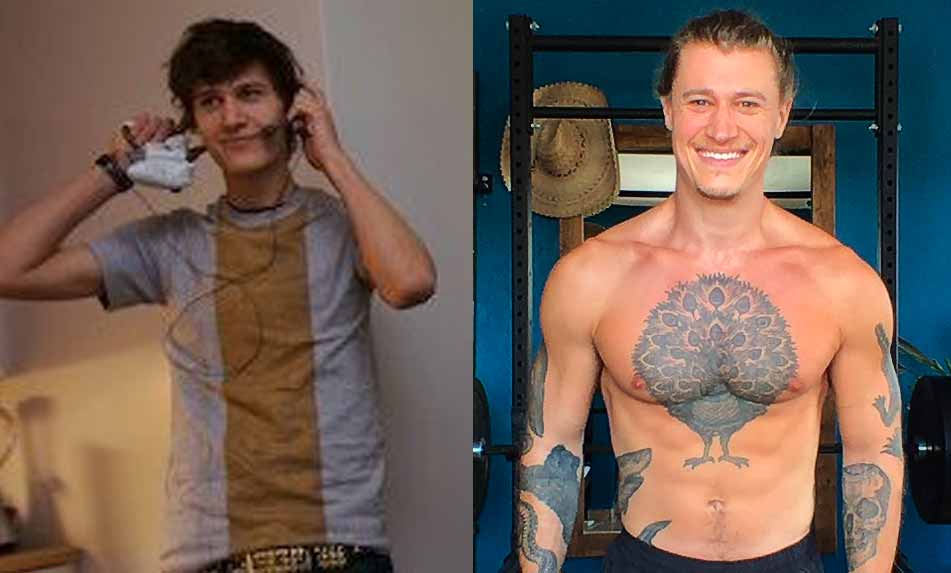
Then research came out showing that training our muscles under a deeper stretch was better for stimulating muscle growth. I decided to apply that to my bench press, and my numbers started to move up again. A year later, I benched 315 pounds for a single, awkward repetition.
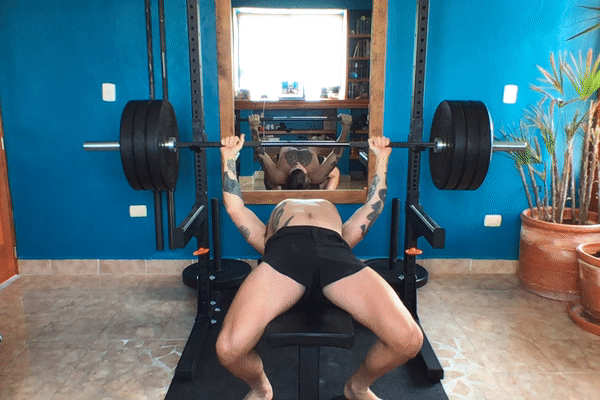
During this time, Marco and I worked with over 10,000 naturally skinny guys, many of them with lagging chests of their own. These are the methods that we use with our clients, that I used to bulk up my own chest, and that brought my bench press from 65 pounds up to 315 pounds.
How to Build A Bigger Chest
Your Chest Should Be the Limiting Factor
To build a bigger chest, it’s not enough to just choose exercises that work your chest muscles. That might work, but it might not. It all depends on how much those exercises are working your chest. It all depends on which muscles are actually limiting your performance. Those are the muscles that are being brought closest to failure, and so those are the muscles that are getting most of the growth stimulus.
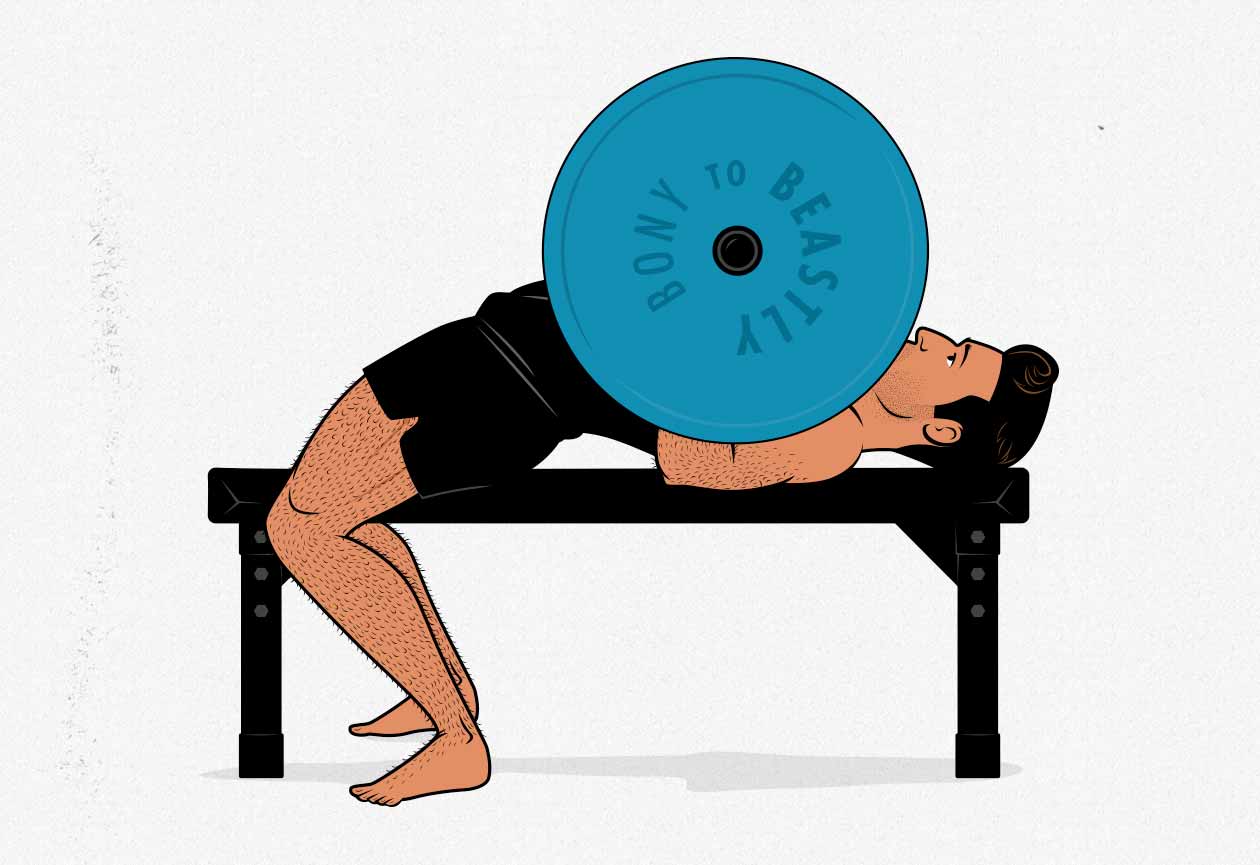
Let’s use the barbell bench press as an example, and let’s imagine three different people doing it:
- Benching for the shoulders: person 1 does the bench press with a moderate grip width, he does a set of 5 reps, and he fails because his shoulder muscles give out. His chest was putting in work, yes. It was engaging. But it’s not all that tired by the end of the set. It hasn’t been challenged. And so it won’t grow.
- Benching for the shoulders and chest: person 2 does the bench press with a slightly wider grip width, he does a set of 8 reps, and again, he fails because his shoulders give out. But this time, his chest worked much harder. In fact, his chest was just about to fail at the end of the set. Both muscles were working hard enough to stimulate muscle growth. Maybe he builds a bit more muscle in his shoulders, but his chest is growing too.
- Benching for the chest and shoulders: person 3 does the bench press with an even wider grip, he does a set of 12 reps, and he fails because his chest gives out. His shoulders were working hard enough to get a decent growth stimulus, but most of the growth stimulus is going to his chest.
If you’re trying to build a bigger chest, you don’t want to be that first person. He’s doing the bench press, he’s getting stronger at it, but it’s a shoulder lift for him, and so his chest will lag behind. It’s much better to be the second or third person, where the bench press is used as more of a compound lift, working both your chest and your shoulders. And if your chest is lagging behind, better to be that third person, where you’re emphasizing your chest with the bench press.
With that said, we don’t need to use the barbell bench press to bulk up your chest. It’s the biggest compound chest exercise, and it does a great job of working your chest, shoulders, and triceps. But there are other lifts that put more emphasis on your chest. For instance, the dumbbell bench press is a smaller lift, and it’s not as good at working your shoulders or triceps, but it’s great for working your chest.
And we don’t need to use the bench press at all. You can build a bigger chest with the push-up, dips, dumbbell fly, pec deck machine, or a wide variety of other great chest exercises. There are plenty of exercises that are great for building a bigger chest, provided that we do them in a way where our chest is the limiting factor.
Work Your Chest Hard Under A Deep Stretch
If your chest is the limiting factor and you bring your sets within 0–3 reps of failure, you can reliably stimulate muscle growth. With enough hard work and patience, it will grow. But we can bulk your chest up much faster and more efficiently if we challenge it under a deep stretch.
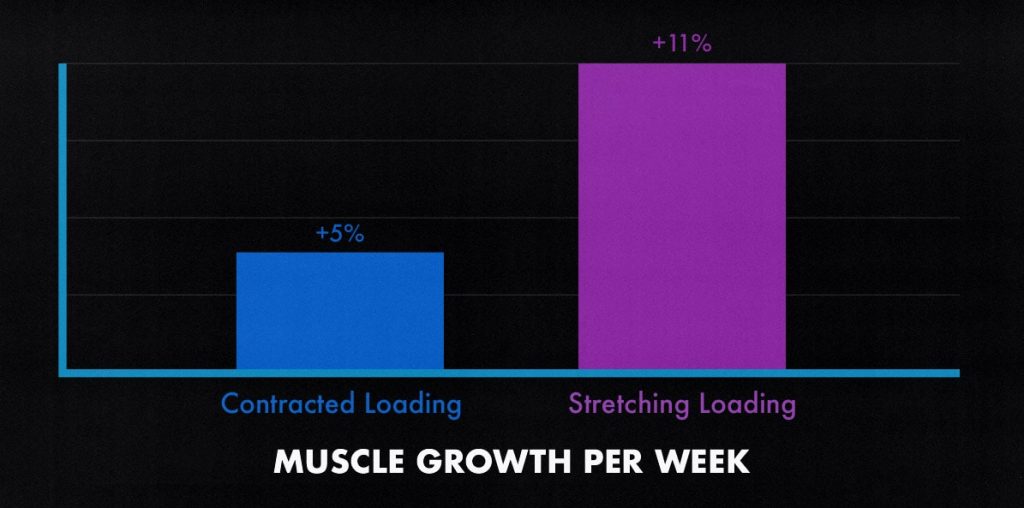
If we look at a meta-analysis of 26 studies, we see that by challenging our muscles in a stretched position instead of in a contracted position, we can build muscle twice as fast. This meta-analysis looked at weighted holds (isometric lifts), but follow-up research found the same effect when working through a full range of motion (study, study). And as more research continues to come out, it’s becoming clearer that challenging our muscles at long muscle lengths is one of the best ways to stimulate more muscle growth.
This doesn’t revolutionize chest training. We’ve known for a long time now that the lifts that work our chests under a deep stretch stimulate the most muscle growth. That’s why there’s so much emphasis on bringing the barbell all the way down to our chests during the bench press, bringing our chests all the way down to the floor when doing push-ups, and using exercise machines that work our chests through a deep range of motion
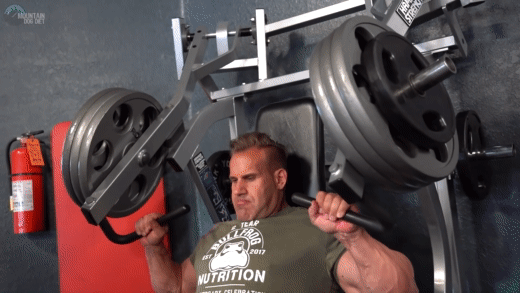
For example, look at how Jay Cutler, four-time Mr Olympia winner, does his chest exercises. He gets a huge stretch at the bottom, lifts the weight a few inches, and then goes back into a deep stretch. He isn’t even bothering to lock the weight out. He’s only doing the part of the lift that works his chest at long muscle lengths.
Is Jay Cutler training his chest this way because he knows all of the latest research? Probably not. It’s probably a method passed around in the bodybuilding community, used year after year, decade after decade because of how efficiently it stimulates chest growth. But as more research comes out, we’re starting to understand why it works so well.
Now, does this mean that you should train your chest with a partial range of motion, only doing the very deepest parts of the lifts? Probably not. You should probably still work your chest through a full range of motion. The trick is to choose exercises with a strength curve that challenges your chest more at the bottom, less at the top. That way you’re not just limited by the strength of your chest, but by the strength of your chest when it’s under a deep stretch.
So, how do we put this into practice?
- Do the bench press with a deep range of motion. The strength curve is already perfect. It’s already hardest at the bottom, especially if you use a moderate-to-wide grip and a modest arch. This is the classic way of doing the bench press. No major adjustments needed.
- The dumbbell fly is probably better than the cable crossover, since it challenges your chest more at the bottom, less at the top.
- Deficit push-ups are better than push-ups, since they work your chest through an even deeper range of motion.
- The pec deck machine and chest press exercise machines are great. Both of them train the chest under a deep stretch, and both are hardest at the bottom of the range of motion.
As you can see, you don’t need to do anything radical. The popular chest lifts can be great for building a bigger chest. You just need to do them with a deep range of motion. Really try to stretch your chest out at the bottom of your lifts.
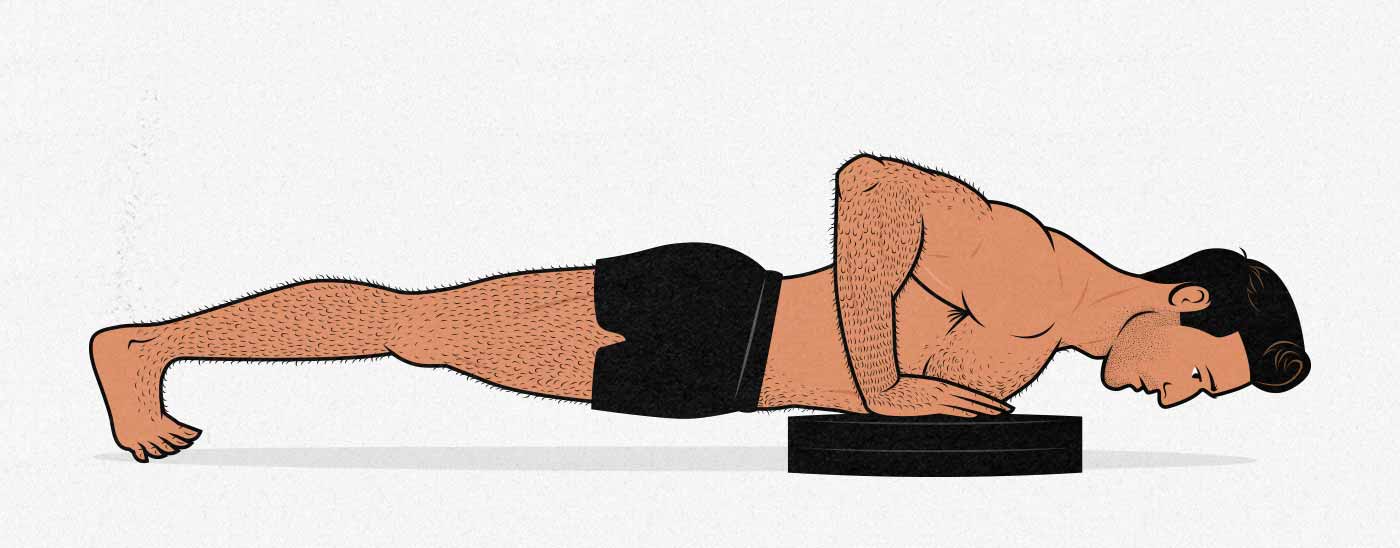
Where this gets more controversial is when we look at electromyography (EMG) research. When our muscles are stretched thin, that means there’s less muscle mass under the electrodes, which reads as lower levels of activation. And when our muscles are contracted, there’s more muscle mass under the electrodes, which reads as higher levels of muscle activation. So if we look at EMG research, the exercises that train our muscles at shorter muscle lengths seem to be better at activating our muscles. That’s why you’ll see a lot of people recommending exercises like the cable crossover or training with resistance bands. But I suspect that might be the wrong call.
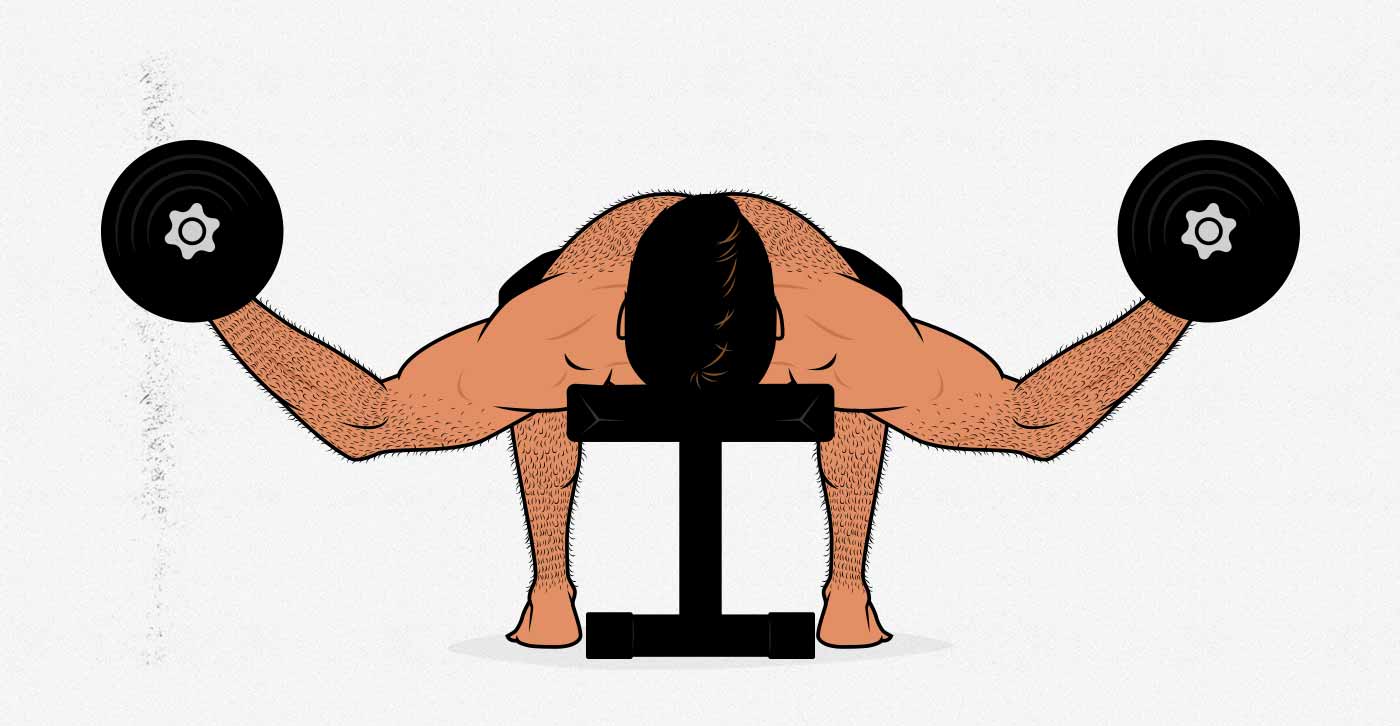
Plus, even though lifts that train our muscles at longer muscle lengths show lower levels of muscle activation in EMG research, they show higher levels of muscle activation when we look at better ways of measuring muscle activation, such as using an MRI (study). And more importantly, if we look at studies measuring actual muscle growth, such as this one, emphasizing the deep stretch has people gaining twice as much muscle.
Get Stronger at Your Chest Exercises
Okay, so once you’ve chosen exercises that are limited by the strength of your chest when it’s under a deep stretch, all you need to do is focus on getting stronger at those exercises. Every workout, try to add a little bit of weight to the bar or eke out an extra repetition. If you benched 185 pounds for 10 repetitions last workout, try to bench 190 pounds for 10 repetitions this time. If you did 18 deficit push-ups last workout, try to get 19 this time.
Now, it’s not quite as simple as it sounds. Stimulating muscle growth is one thing, but to actually gain muscle mass, you need to eat enough protein to build extra muscle tissue, and you need to eat enough calories to gain weight on the scale. That’s how all of this comes together:
- Choose lifts where your chest is the limiting factor, and bring your sets within a couple reps of failure. That will guarantee that you’re stimulating muscle growth in your chest.
- Work your chest under a deep stretch to roughly double the muscle-building stimulus, allowing you to build a bigger chest much faster.
- Eat enough protein to rebuild your muscles, and enough calories to add extra mass to your frame. Because you’ve stimulated your chest, some of that new muscle mass will be packed into your pecs.
- Because you’ve gained muscle, you’ll show up to your next workout stronger, and so you’ll be able to lift a little more weight or grind out sightly more repetitions. This is progress.
Give that process enough time, and your chest will grow bigger, guaranteed, no matter how stubborn it is, and no matter how far it’s been lagging behind.
How to Get More Chest Growth Out of Your Chest Exercises
How to Engage Your Chest When Doing the Bench Press
Bench With a Wider Grip
Guys with stubborn chests often find that their shoulders and triceps take over when they do the bench press. That isn’t necessarily a problem. It’s a compound lift, and building bigger shoulders and triceps is great. But if you’re trying to build a bigger chest, it can help to adjust your technique so that your chest becomes the limiting factor.
The easiest way to emphasize your chest when benching simply to use a wider grip, more elbow flare, and to touch the barbell a bit higher on your chest (instead of your sternum), like so:

When you bench with a wider grip, it increases the moment arms on your chest while decreasing them for your shoulders and upper chest. This puts more of the load on your chest, less on your shoulders. And so your chest will be forced to do more of the work, giving it a much better growth stimulus.
Bench With Dumbbells Instead of a Barbell
Our chest works in a hugging motion, as it does when doing a dumbbell fly. When doing the barbell bench press, though, the barbell prevents the weights from falling away to the side, which makes the lift much easier for your chest and much harder for your triceps. This prevents your chest from becoming too dramatic of a limiting factor, and it allows your triceps to assist with the lift. This is why the barbell bench press is so much heavier, and why it makes for such a great compound lift.
The downside to the barbell bench press, though, is that it’s possible for your triceps to fail long before your pecs, preventing your chest from being challenged enough to provoke muscle growth. The solution, then, is to ditch the barbell and do the dumbbell bench press instead.
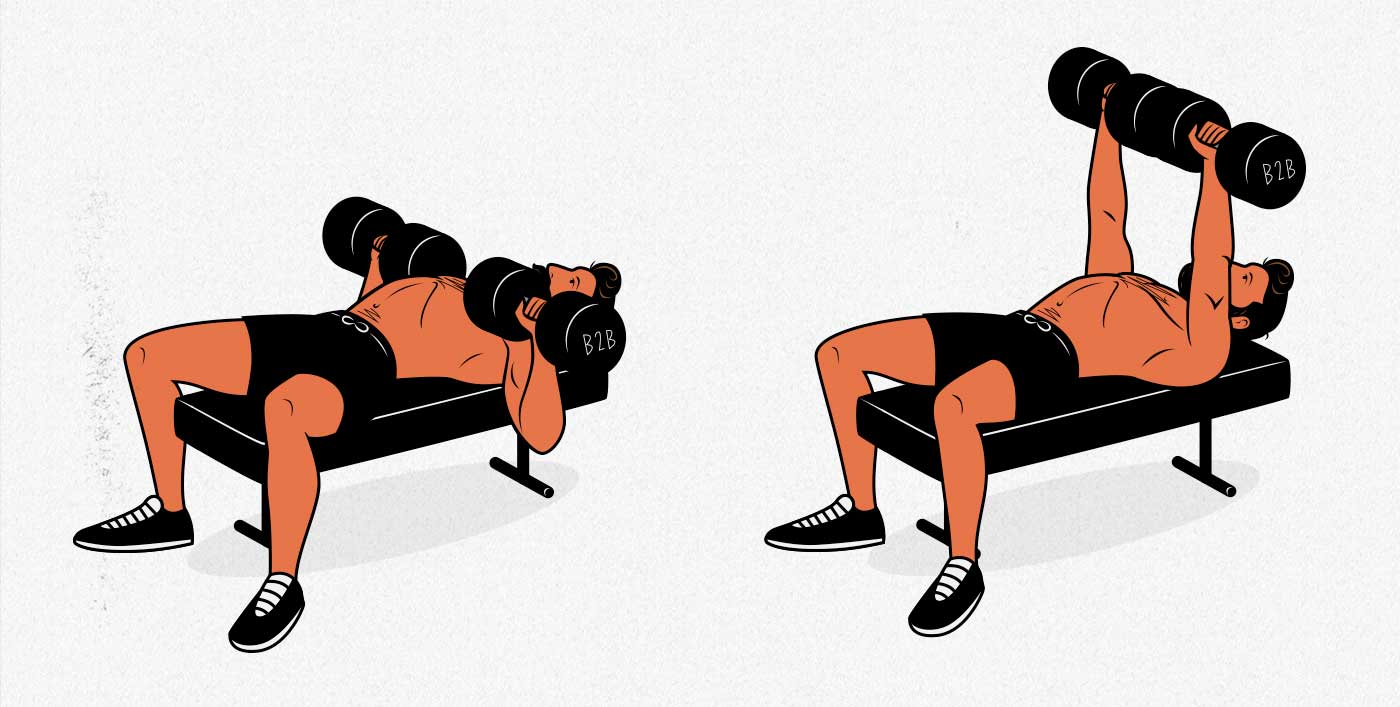
With a dumbbell bench press, your chest will need to fight to keep the weights from falling away to the sides. It’s a combination of a chest press and a chest fly, making the lift much harder on your chest muscles.
Bench Deeper, Giving Your Chest a Better Stretch
The next thing you can do to get more chest growth out of your bench press is to bench deeper, putting your chest under a great stretch. You’ll see some experts, such as Jeff Cavaliere (of Athlean-X), recommending that we bench with a flat back and partial range of motion. And sometimes, it’s true, beginners have trouble bringing the barbell all the way down to their chests. I remember when I first started building muscle, I was really skinny, my shoulders were very weak, and I couldn’t bring the barbell all the way down to my chest without shoulder pain.
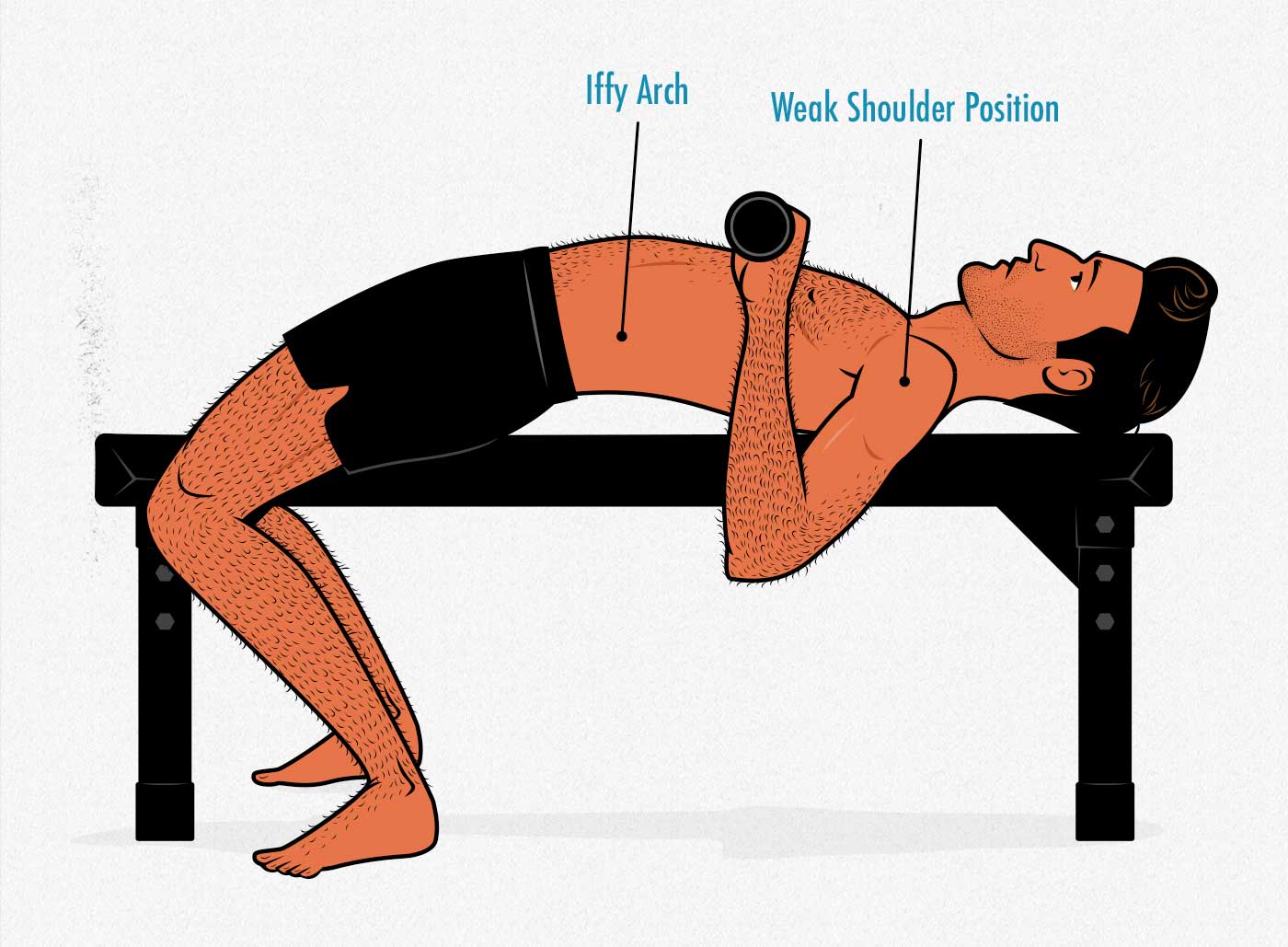
Ideally, though, you’d work on improving your range of motion, learning how to bench with a modest arch and how to pinch your shoulder blades down and back. Maybe you need to start with a board press, dumbbell bench press, or push-up. That’s totally fine. Doing the push-up and dumbbell fly is a great way to build a bigger chest. But over time, you should be able to develop the range of motion needed to bring the barbell all the way down to your chest. And when you can, I bet you’ll find that your chest size and bench press strength really starts to explode.
For more, we have a full article about how to approach lifting as a skinny beginner.
Use a Moderate Rep Range
The bench press is a big compound lift that can be done in lower rep ranges, and there’s nothing wrong with that. The only problem is that when you’re benching for 1–8 reps per set, it tends to demand quite a bit of your shoulders and triceps. And if your shoulders and triceps limit your performance, it can make it harder to build a bigger chest.
For most people this isn’t a problem. Most people are chest dominant in the bench press. When they bench in lower rep ranges, they get more shoulder and triceps growth, and it doesn’t hurt their chest growth. It just becomes a bigger compound lifts. But if you’re trying to use the bench press to specifically build a bigger chest, you might want to try using a higher rep range. When we bench for sets of 9–12 reps, it tends to be easier on your shoulders and triceps, harder on your chest.
How to Engage Your Chest With Push-Ups
Push-Ups Are As Good As the Bench Press
As we cover in our bodyweight workout article, push-ups are comparable to the bench press for building a bigger chest. In this study, for instance, there’s no significant different in chest growth from doing push-ups versus the bench press. Both are equally good.
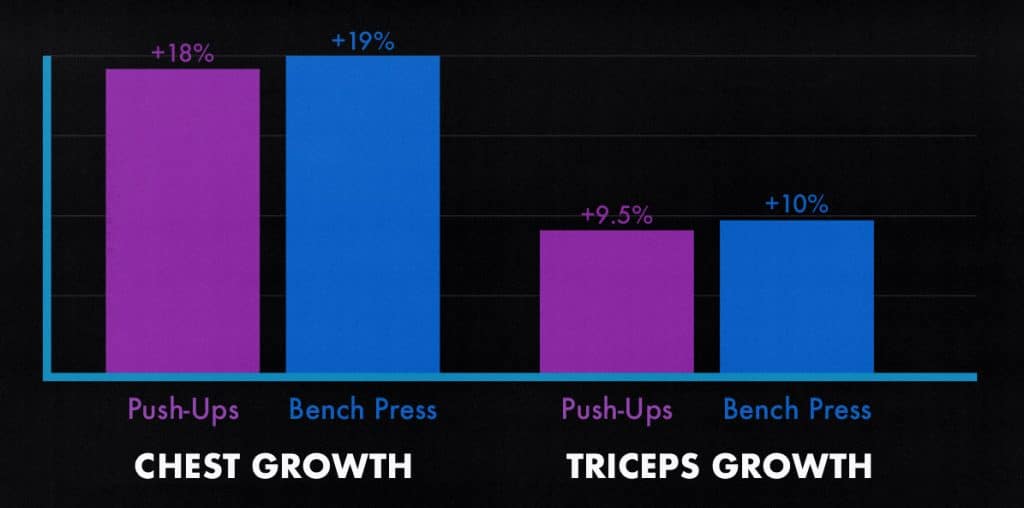
There are a few implications here. First, if you don’t have a barbell or dumbbells, no problem, you can build a bigger chest without any equipment at all. Just do push-ups. Second, push-ups are a great chest lift to add into your routine, even if you have access to weights. You can do the bench press and push-ups.
Do Deficit Push-Ups to Get a Deeper Stretch
Once you can do flat push-ups for around 10–20 repetitions with great technique and a full range of motion, bringing your chest all the way down to the floor, you can switch to the deficit push-up. The deficit push-up is where you raise your hands up on push-up handles, weight plates, or speculative fiction novels, allowing your chest to sink deeper than your hands, like so:

By bringing your body lower than your hands, you can put your chest under a maximal stretch, boosting the amount of muscle growth that you stimulate. As a result, the deficit push-up may stimulate even more chest growth than the bench press. The only downside is that it’s harder to load as heavy, meaning that you may eventually outgrow it.
With that said, the deficit push-up will grow with you. As you gain weight, your body will get heavier, and so the load will increase. I can bench 315 pounds, and if I do my deficit push-ups after the bench press, I can’t get more than 25 reps, which is still well within the hypertrophy rep range. Every workout, I fight to get an extra rep. Eventually, I’ll need to get a weighted vest. But that day hasn’t come yet.
Keep Your Push-Ups Flat
One mistake that a lot of people make is that as they get stronger at the push-up, they start to raise their feet up. That makes sense. It shifts more of your body weight onto your hands, making the push-up heavier. Problem is, it also shifts more of the load onto your shoulders. It turns the push-up into a sort of incline bench press. That makes it harder to activate the big muscles in your mid and lower chest. It becomes less of a chest lift.
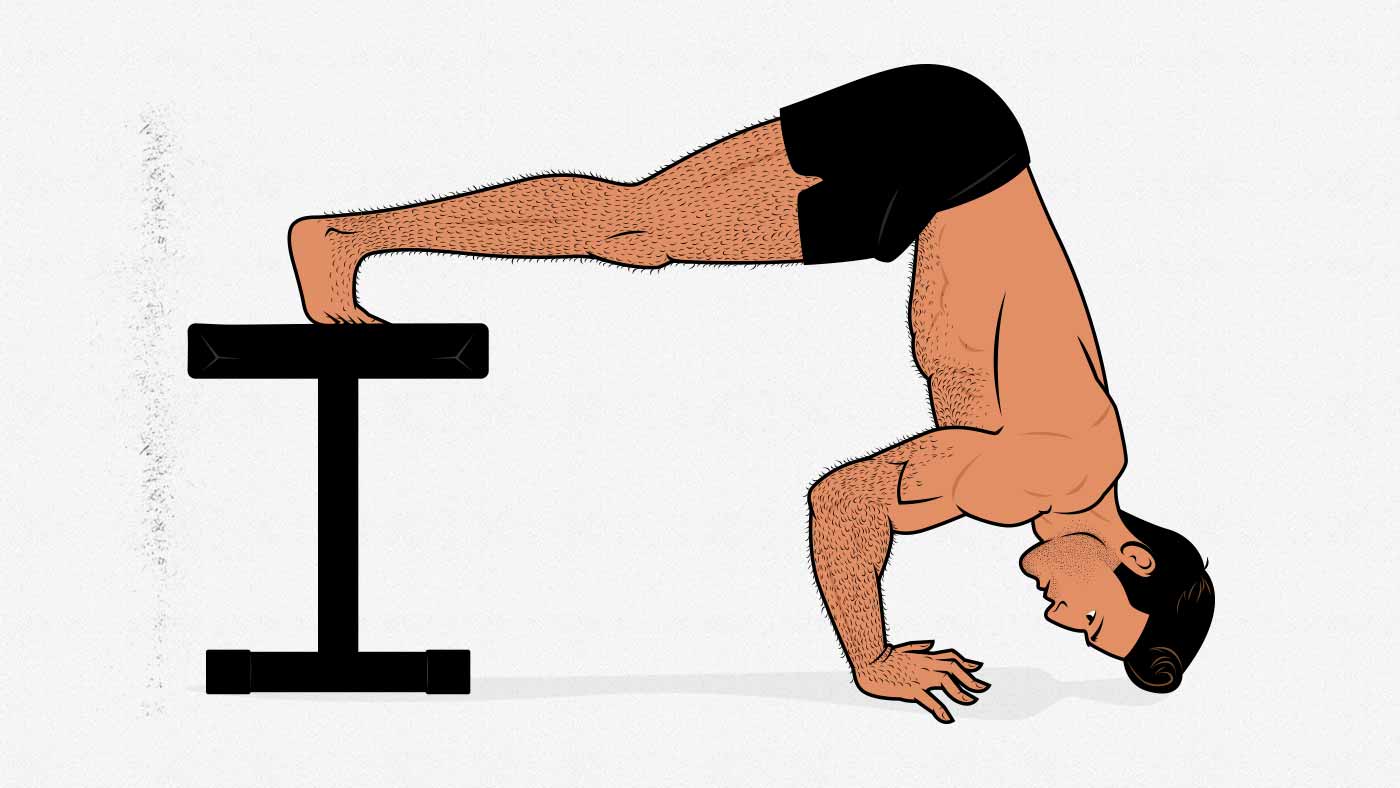
Now, that doesn’t mean that you can’t raise your feet up. It just means that if you raise your feet up, make sure that you raise your hands up as well. That way you’re doing deficit push-ups with your feet raised. That’s great.
How to Build a Bigger Chest With the Chest Fly
If you do a good job of stimulating your chest with the bench press and push-up, you might not need a chest isolation lift. The chest is a simple muscle. It can activate fully during compound lifts and it doesn’t need a wide variety of exercises. But if your chest is lagging behind, the chest fly is a great chest isolation exercise to add into your workout routine.
There are a few different ways of doing the chest fly, though, and some are better than others.
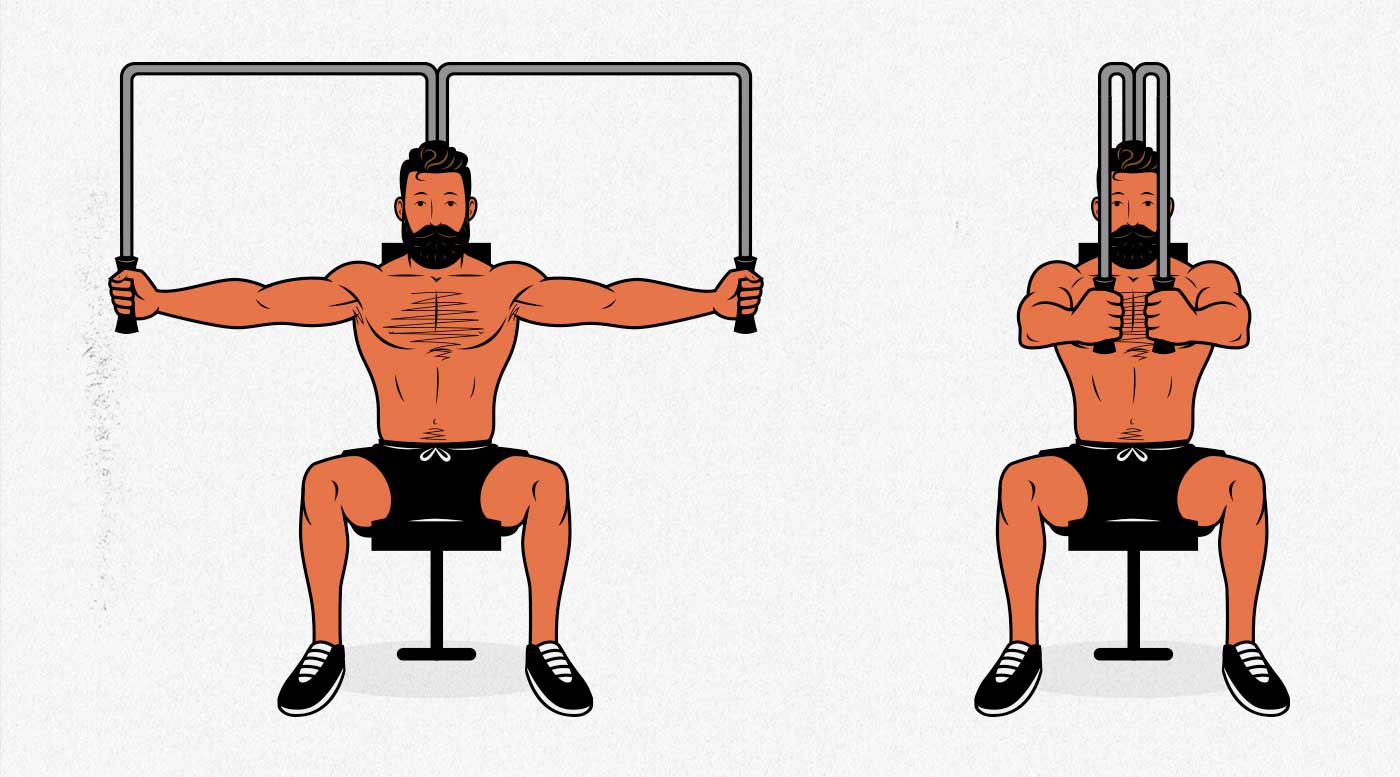
First, we have the chest fly and pec deck machines. It’s common to hear that exercise machines aren’t as good for stimulating muscle growth as free weights, but that doesn’t bear out in the research. Exercise machines are equally good at stimulating muscle growth (study). Plus, these exercise machines do an amazing job of working our chest muscles under a deep stretch.
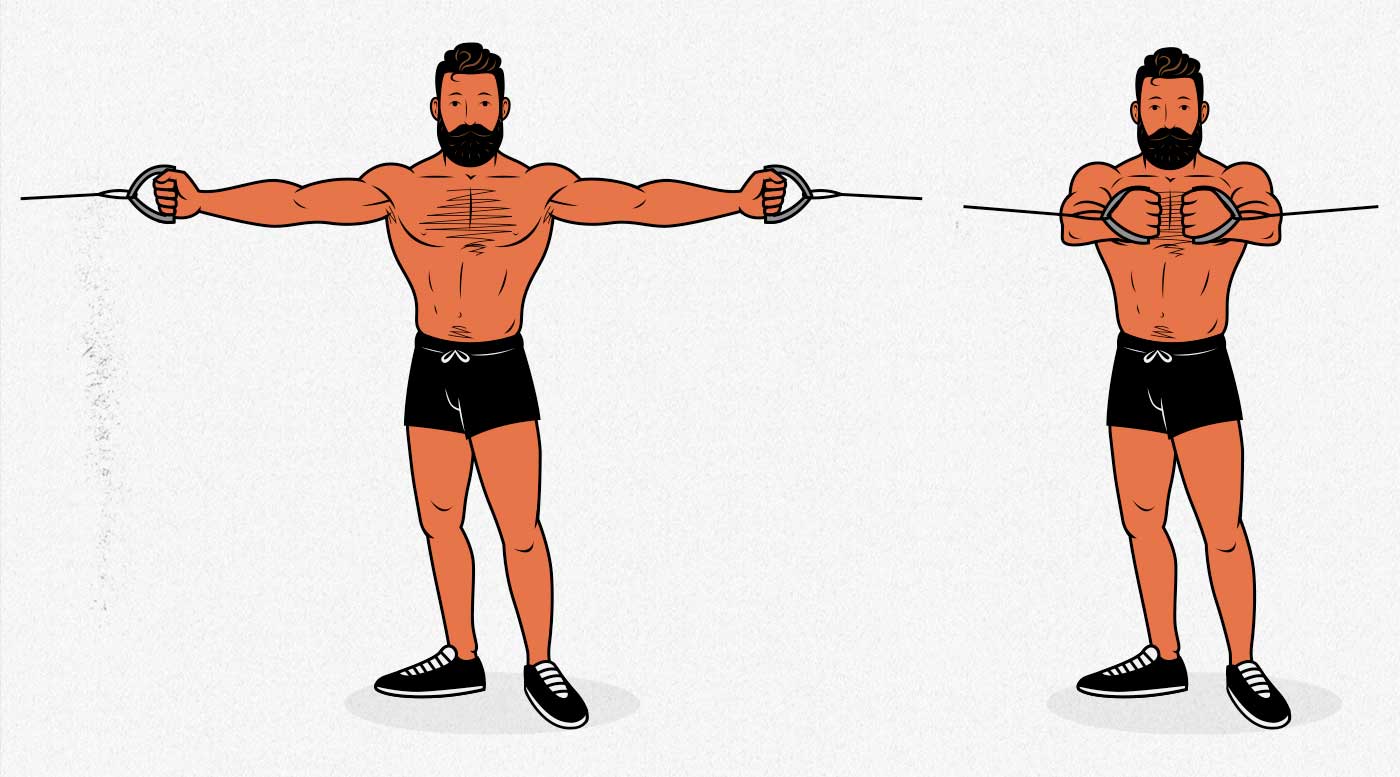
Next, we have the cable crossover. This is the fancier chest exercise that a lot of bodybuilders prefer. It’s a bit harder to do, and it has a bit of a funny strength curve. People like it because it works the chest harder in a contracted position, which is good for getting a pump, but not as good for actually building muscle. You can do these if you want, but I think the other variations are better for building a bigger chest.
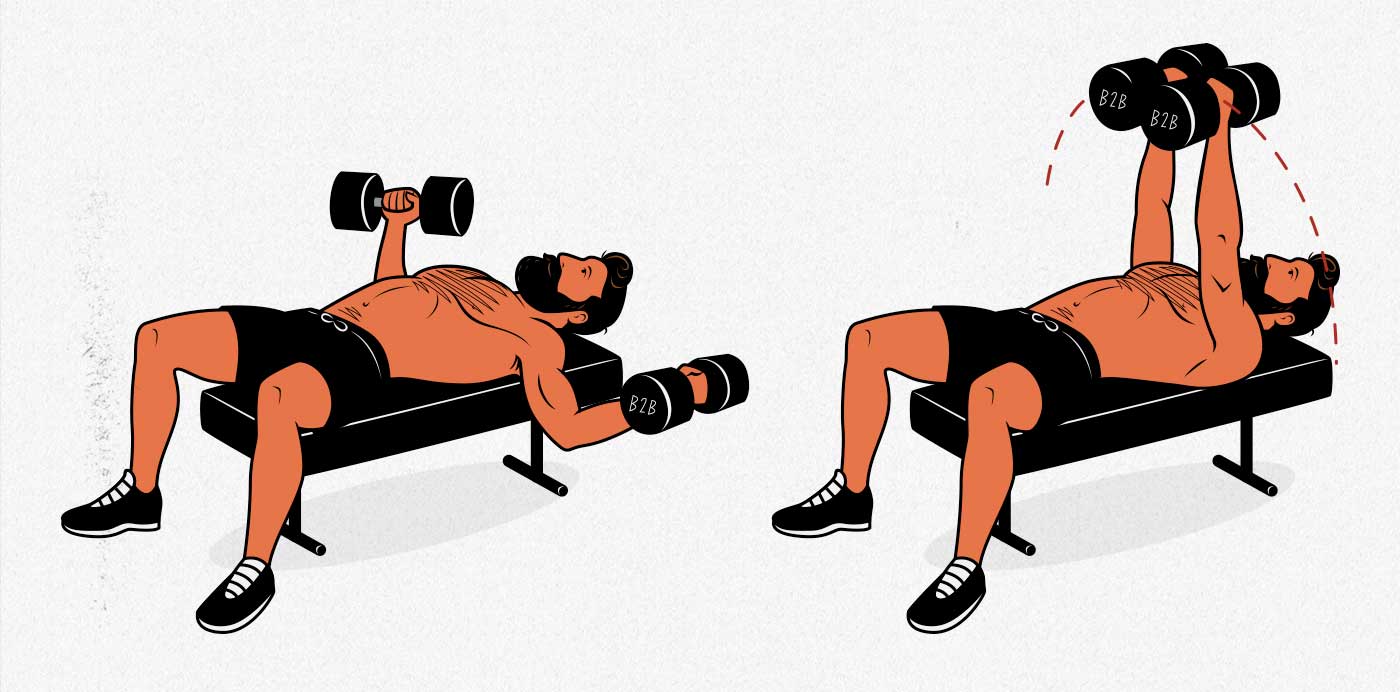
Finally we have the dumbbell fly. Some bodybuilders eschew this exercise because it’s only hard at the bottom of the range of motion, but that’s exactly why it’s great. It’s disproportionately hard when our chests are fully stretched. That’s the most important part of the range of motion, the best place for the lift to be hardest. That’s why it’s so good.
The trick with the dumbbell fly is to lower the weight down slowly, getting a really deep stretch on your chest. It’s that stretch at the bottom of the range of motion that’s magic, so make sure to go nice and deep.
How to Build a Bigger Upper Chest
Is Your Upper Chest Lagging Behind?
It’s certainly possible that your upper chest is lagging behind, but if your chest is small overall, it’s not because of your upper chest. Thing is, your upper chest (connected to your collarbones) is much smaller than your mid and lower chest (connected to your sternum). And I don’t mean that it’s smaller because it’s lagging behind, I mean that your upper chest is just a much smaller muscle. It will always be smaller.
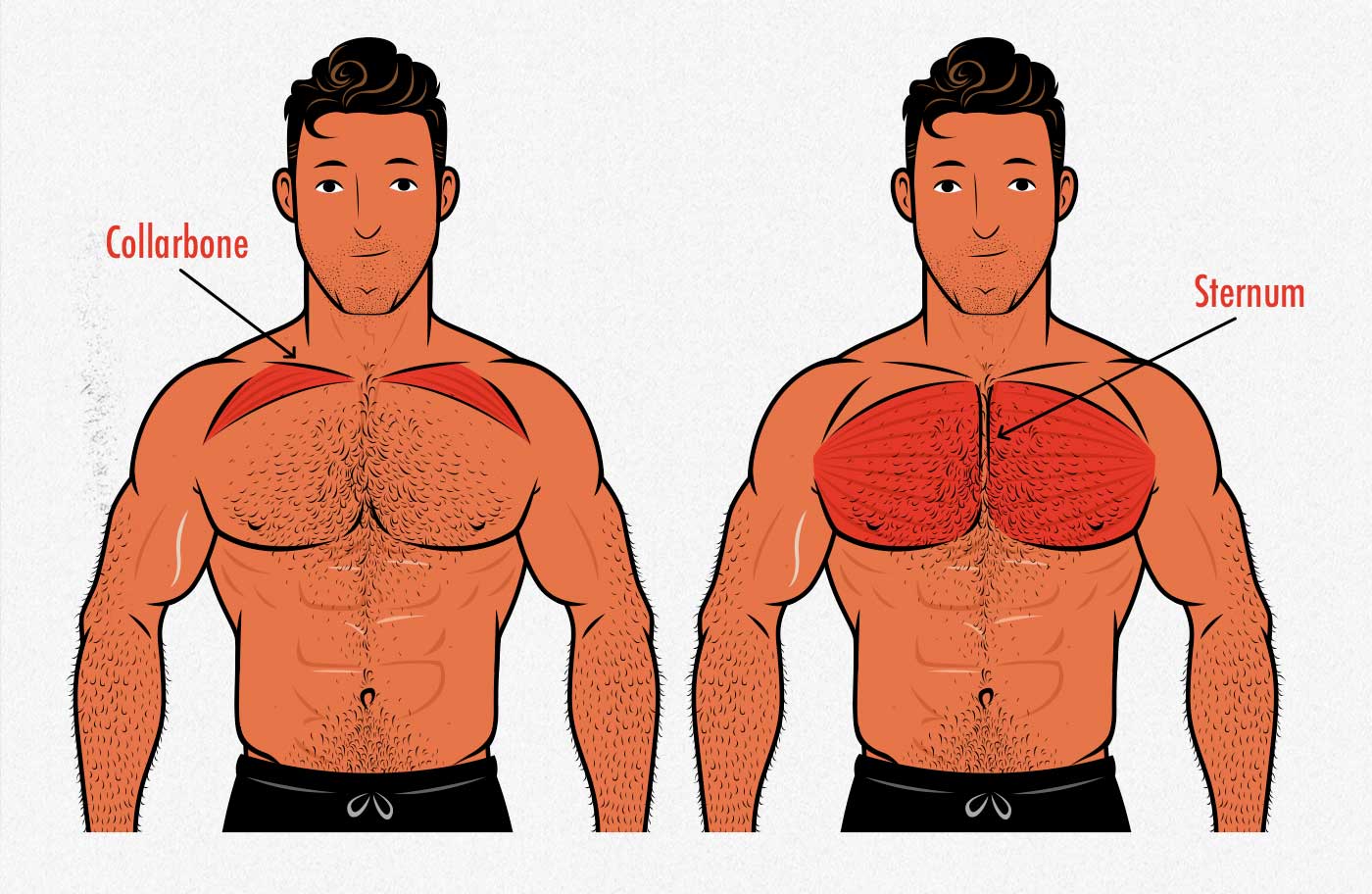
So if you have a small chest overall, it’s not a great idea to emphasize the smallest part of your chest. It’s much better to focus most of your efforts on the bigger, heavier chest exercises that will help you build a bigger chest overall. Think of the bench press and push-up. These lifts will bulk up your entire chest.
With that said, the bench press, push-up, and overhead press will engage your upper chest, but maybe not enough to maximize muscle growth there. In all these lifts, your upper chest probably won’t be the limiting factor, and so it may or may not lag behind. That’s why it can help to add in some lifts that target it directly.
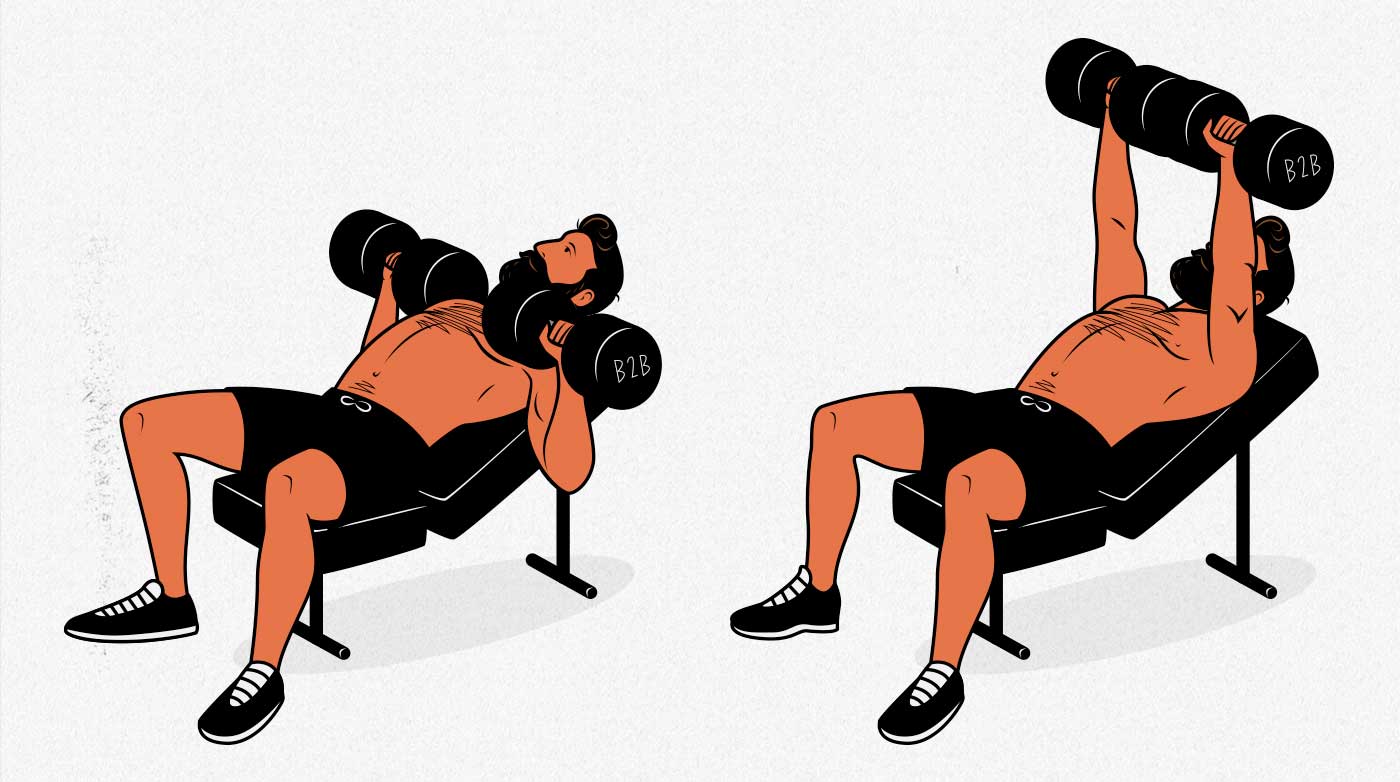
The easiest way to build a bigger upper chest is to include some close-grip or incline bench pressing in your routine. The close-grip bench press will work your upper chest and shoulders through a deeper range of motion, whereas the low-incline bench press (with a bench angle of around 30 degrees) is the tried and true upper chest exercise. You can choose either one. If you do a few sets once or twice a week, you shouldn’t have any trouble building a bigger upper chest.
The Best Chest Workout
To build a bigger chest, you’ll probably want to train your chest 2–3 times per week using a variety of different chest exercises. You can pick those exercises based on what works your chest the hardest:
- Heavy compound exercises. Which exercises feel like they’re putting the most tension on your chest at the bottom of the lift, when your chest is stretched out? These will make good primary chest exercises. Think of the flat barbell bench press, the dumbbell bench press, the deficit push-up, or the weighted dip.
- Lighter isolation exercises. Which lifts give you the biggest chest pump when you lift in higher rep ranges? These will make good secondary chest exercises. Think of the deficit push-up, the pec deck machine, the chest press machine, or the dumbbell fly.
- Upper chest exercises. To build a balanced chest, you’ll probably want at least one exercise in your routine that emphasizes the upper chest. I recommend picking between the close-grip bench press, the incline bench press, and the deficit push-up. The low-incline bench press is the most popular, and it’s a great choice.
Once you’ve experimented with the exercises, finding the ones that work best for you, program a primary and secondary chest exercise each workout. For example:
Workout One
- Flat Barbell Bench Press: 4×10 (3 sets of 10 repetitions)
- Deficit Push-Up: 3xAMRAP (as many reps as possible)
Here we’ve got the flat barbell bench press as your primary chest exercise, and we’re using it to target the bigger fibres in your mid chest. We’re lifting on the heavier side of the hypertrophy rep range. In this case, we’ll default to 10 reps, but anywhere between 6–12 reps will work well. And doing 4 sets is probably enough to get virtually all of the growth stimulus, but anywhere between 3–5 sets will do, depending on how fatigued the sets are making you.
Then we’ve got the deficit push-up as the secondary exercise, this time done in higher rep ranges, and this time chosen because it’s slightly better at stimulating the muscle fibres in our upper chest. For this exercise, we’ll lift on the lighter side of the hypertrophy rep range, trying to do as many reps as you can, and perhaps getting 15–30 reps per set. The goal here is to pump your chest up, flooding it with metabolites, to give it some extra volume, and to make sure that we’re stimulating all of the fibres in your chest.
The most important thing is that every workout, you’ve got to fight to add a bit of weight or eke out more reps. Maybe that means adding 5 pounds to the barbell, or maybe it means getting an extra rep in your third set. The important thing is that you’re always striving to outlift yourself. That’s how you build a bigger chest.
Workout Two
- Dumbbell Bench Press: 3×12
- Pec Deck Machine: 3×20
Here we’ve got the dumbbell bench press as your primary chest exercise, and we’re using it to target the bigger fibres in your mid chest. What makes the dumbbell bench press so good is that it does a great job of forcing your chest to do the majority of the work. We’re lifting right in the middle of the hypertrophy rep range. In this case, we’ll default to 12 reps, but anywhere between 8–15 reps will work well. And doing 3 sets is probably enough to get most of the growth stimulus, but anywhere between 3–5 sets is great.
After that, we’ve got the pec deck machine (or dumbbell fly) as the secondary exercise. It’s a great lift for isolating your chest, and it’s great for guys with lagging chests. For this exercise, we’ll lift on the lighter side of the hypertrophy rep range, doing 15–30 reps per set. In this case, we’ll default to 20 reps. Again, the goal here is to pump your chest up, flooding it with metabolites, and to give it some extra volume.
The Full Workout Routine
The idea is to alternate between these two workouts, training our chest 2–3 times per week with at least a day of rest between each workout. For example, you might do the first workout on Monday, the second workout on Friday. Or, if your chest is small and recovers more quickly, perhaps you do them Monday, Wednesday, and Friday.
Keep in mind that these aren’t full workouts. These are just the exercises for your chest. The idea is to build your workouts around those exercises. You can work those exercises into full-body workouts, do them on the upper-body days of an upper/lower split routine, or do them on the push days of a push/pull/legs routine.
For example, if you’re doing full-body workouts, maybe your workouts look something like this:
- Flat Barbell Bench Press: 4×8
- Front Squat: 3×8
- Deficit Push-Up: 3xAMRAP (as many reps as possible)
- Barbell Row: 3×8
- Neck curls: 2×20
Or if you’re doing an upper-body workout, maybe it looks more like this:
- Flat Barbell Bench Press: 4×10
- Barbell Row: 3×15
- Deficit Push-Up: 3xAMRAP (as many reps as possible)
- Barbell Curl: 2×12
- Forearm curls: 2×20
Or if you’re doing a push workout, something like this:
- Flat Barbell Bench Press: 4×6
- Overhead Press: 3×8
- Deficit Push-Up: 3xAMRAP (as many reps as possible)
- Skull crushers: 2×18
- Lateral raises: 2×20
These are just examples. Feel free to customize your workouts based on which exercises you prefer, what equipment you have access to, what feels best on your joints, and what works your chest the hardest. Everyone is a bit different, so feel free to make it your own.
You can also adjust how many sets you do and how often you train. The idea is to work your chest hard enough to get a good pump and make it a bit sore for the next couple of days. Then, once your chest stops being sore, you train it again. For some guys, it might take two days for their chests to recover. For others, it might take a good four days. And that may change as your chest gets bigger and stronger. For instance, I used to be able to train my chest every second day, but I was only benching 185 for sets of 6. Nowadays, doing 275 pounds for 6 reps, I can only do a hard chest workout every 4–5 days.
Summary
To build a bigger chest, you need to choose exercises where you’re limited by the strength of your chest. That will ensure that you’re stimulating muscle growth with every set. And to stimulate even more muscle growth, try to choose exercises that challenge your chest under a deep stretch.
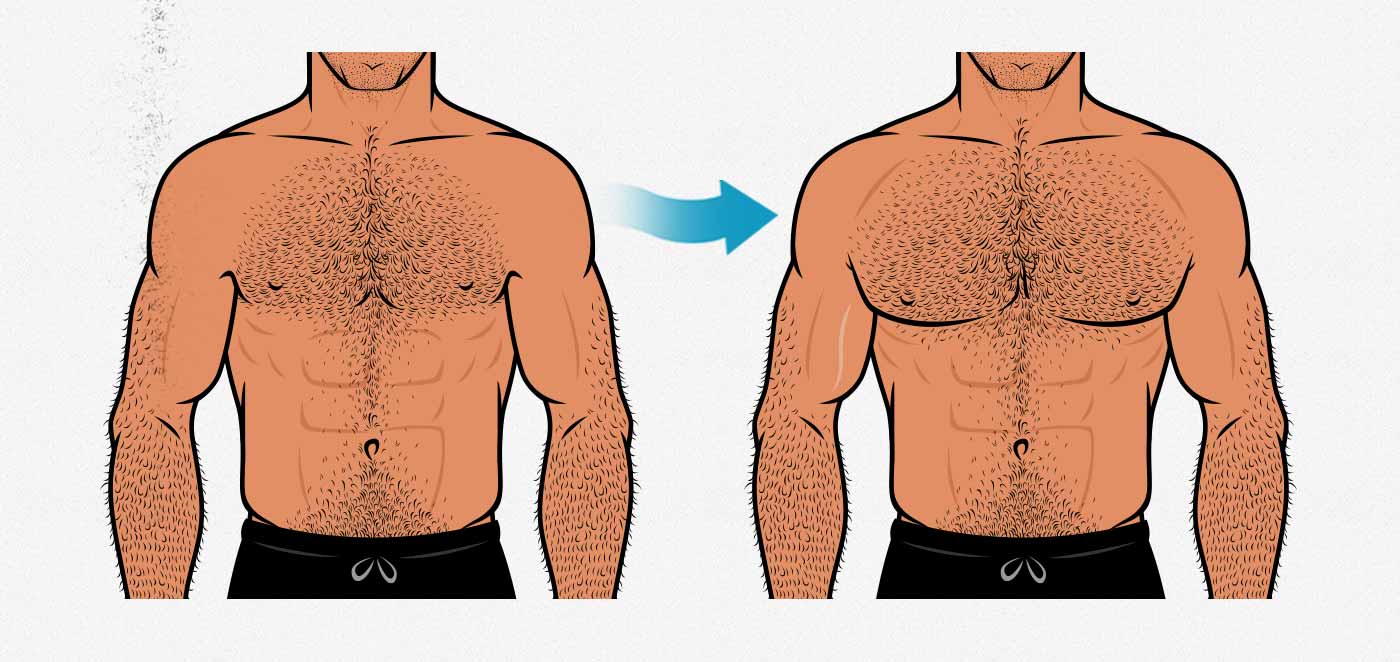
Once you’ve chosen good exercises, you’re using a deep range of motion, and you’re bringing your sets close to failure, all you need to do is fight to make a little bit of progress every workout. Write down what you’re lifting and try to beat it next time, adding a bit of weight to the bar or fighting to squeeze out an extra rep.
To be able to lift more than last time, you need to get bigger and stronger. Stimulating muscle growth is part of that, but so is your diet. Make sure that you’re eating enough protein and enough calories to actually build muscle and gain weight.
It only takes 2–3 days for your chest to recover from a hard workout. That means that if you want your chest to be growing steadily all week long, you should be training it 2–3 times per week. During those workouts, do 1–2 chest exercises, doing 2–4 sets per exercise, and bringing those sets within 0–3 reps of failure. That’s all it takes.
It often helps to focus on getting stronger at a few key exercises that will reliably bulk up your chest. Here are some good ones to build your workout routine around:
- The Barbell Bench Press: this is the best chest exercise, and it’s a great compound lift for your shoulders and triceps, too. Use a moderate or wide grip, bench deep, and do at least 9 reps per set.
- The Dumbbell Bench Press: if you have trouble feeling your chest working during the barbell bench press, and if it doesn’t leave your chest feeling sore afterwards, the dumbbell bench press is a great alternative. It does an even better job of emphasizing your chest, albeit at the cost of your triceps.
- The Deficit Push-Up: this is the best bodyweight chest exercise, and it’s just as good as the bench press for bulking up your chest. The only downside is that it’s harder to progressively overload. But that isn’t a problem until you can do 30+ repetitions.
- The Chest Fly: this is the best chest isolation exercise to pair with the bench press or push-up, either as a follow-up exercise or even as a superset. Doing the chest fly with dumbbells or on an exercise machine is probably ideal for stimulating muscle growth, but some people prefer the cable crossover.
- The Close-Grip or Incline Bench Press (upper chest). These are the best lifts for building a bigger upper chest. Both are great, so just choose the one that you prefer.
If you’re still new to lifting weights and you haven’t gained your first twenty pounds of muscle yet, our Bony to Beastly Bulking Program will be perfect for you. It’s a 5-month program made up of three full-body workouts per week, each of them containing a couple of chest exercises. It’s designed to be perfect for building a strong, full chest.
But if you’re a seasoned lifter who’s already gained at least twenty pounds, or if your chest is stubbornly lagging behind the rest of your muscles, then we recommend our chest specialization program: War Chest.
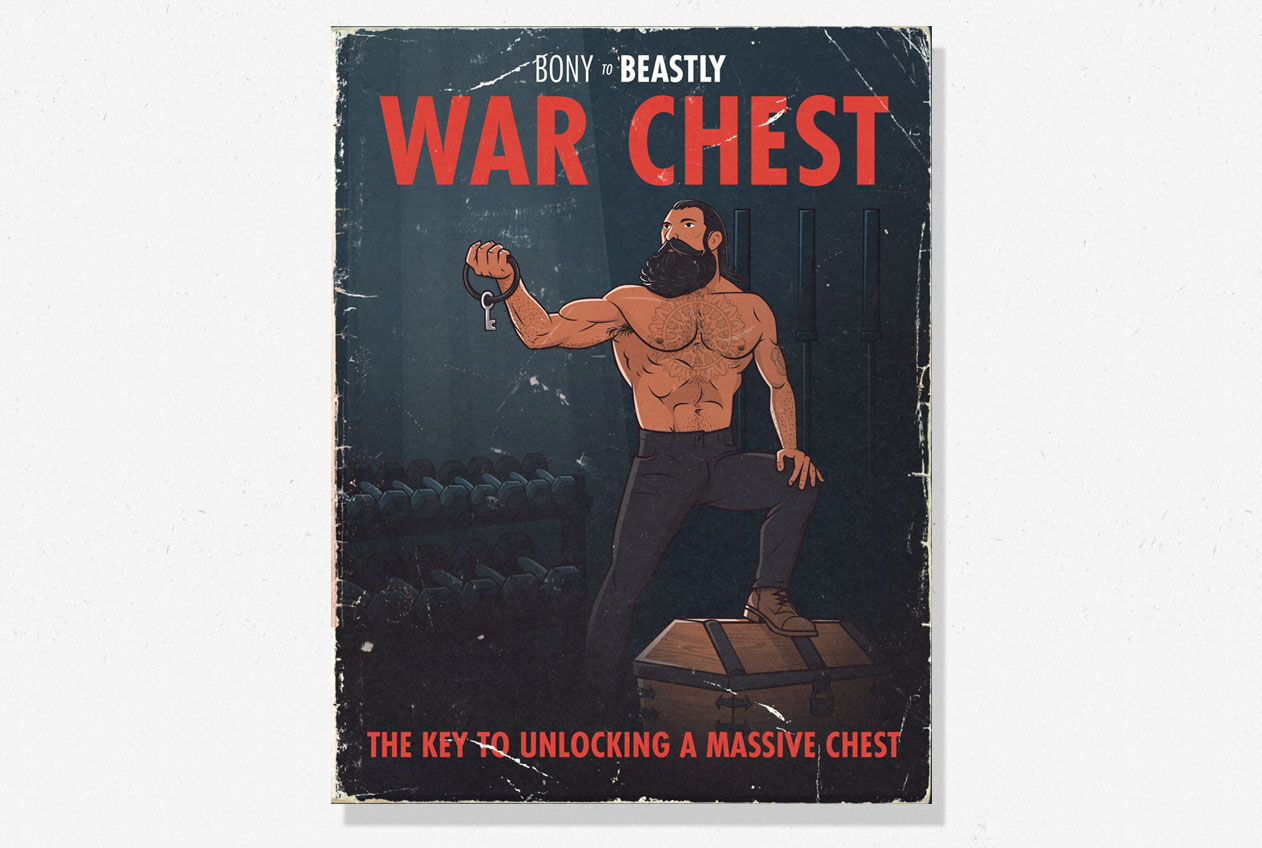
It’s a full 50-page guide, including an 18-week periodized chest workout program—all of it designed to get you as much chest growth as physically possible. Every muscle group will be worked, but there’s a huge emphasis on helping you build up a truly massive chest.

